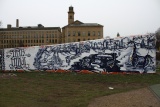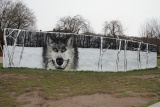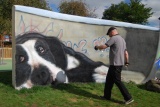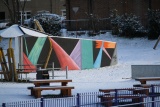Roberts Park
| Address | Higher Coach Road |
|---|---|
| Postcode | BD17 |
| Built | 1871 |
| Built by | Design-William Gay for Titus Salt. Build-Lockwood & Mawson |
| Refurbished | 2010 |
| Designation | UNESCO World Heritage Site with several listed buildings. |
| Photo | |

| |
| Open Street Map | |

| |
| Other Links | Google Maps |
There is also another area of Baildon that was for some years called Roberts Park at Wood Bottom.
Roberts Park is in Baildon and in December 2001 UNESCO designated Saltaire including Roberts Park as a World Heritage Site. Over a number of years the park had become run down but using Lottery funding it was restored, with the work starting in 2009. Most of the work was completed in 2010 but the installation of 2 large urns was done in 2016 and two cannons in 2017.
The park was designed and laid out for Titus Salt by William Gay and was opened on 25 July 1871. The work was done by Lockwood & Mawson who built the neighbouring and associated Saltaire village for Titus Salt. In 1891 the park was purchased by (Sir) James Roberts (1848–1935). Saltaire Park was given to the people of Shipley (through Shipley Urban District Council) by James Roberts the manager of Salts Mill in 1910. James Roberts was the newly elected chair of Shipley Urban District Council, but after a disagreement the park was taken back and given to Bradford Council in 1920 as Roberts Park.[1]

This is a photo of the stone next to the lodge of the park at the east entrance that reads:-
Roberts Park Presented to the city of Bradford by Sir James Roberts Bart JP and Lady Roberts as a Memorial to their late son Bertram Foster Roberts January 1920
Roberts Park is connected to Saltaire via a footbridge though there used to be a road bridge across the river as a continuation of Victoria Road. The first bridge was being planned in 1852 and passed for public use in 1855 though it is thought it was already in use. This bridge was demolished after only 12 years and replaced with a new one that reused some of its features and was completed in 1868. Apparently tanks crossed this bridge during WWII and caused significant weakening of it. The bridge was closed in the 1950s and removed in the 1960s. There are a few photos of removal of the bridge - Victoria Road Bridge Removal

Building Refit & Heritage Listings
The buildings within Roberts Park are listed as is Roberts Park.
The listing for Roberts Park can be seen here
Lodge at East Entry to Park

The listing for this can be seen here


This photo shows the Lodge at the entrance to Roberts Park clad in scaffolding during its refit. Taken May 2009.

Inside one of the rooms of Roberts Park Lodge during refit 2010.
Statue of Sir Titus Salt
The listing for this can be seen here
Extract: Statue of Sir Titus Salt. 1903 by F. Derwent Wood (Chelsea) for Mr. J. Roberts the director of Saltaire works from 1893. Ashlar base, bronze plaques and statue. North facing.[1]

Sir Titus with Seagull

This photo shows the newly erected and painted bandstand with the statue of Titus Salt behind on the flat roof balustrade of the Half Moon Cafe.
Tea Room, Balustrade and flanking steps

The tea room is called the Half Moon Cafe.
The listing for this can be seen here

The photo above shows the Half Moon Cafe and balustrade. This was taken on 15 Sept 2012 during the Saltaire Festival. A group of Steam Punk can be seen on the balustrade.

This photo is of the interior of the Half Moon Cafe during the refit in 2010.

During the refit of the Half Moon Cafe in 2010 tiles were found and replicated for the walls. The colours in the tiles were also used for the colour scheme of the park.


The colours used on the benches and bins in Roberts Park are based on the colours in the tiles found in the Half Moon Cafe.

The colours of the bandstand are also part of the colour scheme.
West Shelter


The metal benches along the path,seen in the 1999 photo, have been replaced with timber and wrought iron benches that will be similar to those originally in the park.
The listing for this can be seen here
East Shelter

The listing for this can be seen here
The text of the listing is the same as the text for the North shelter that can be read below.

Early days of the East Shelter refit.

The rooves of the shelters were restored using traditional designs.

This shows the bench inside the East Shelter in the process of being built.

The colours used in painting the arches of the shelters were based on the colours of the tiles in the Halfmoon Cafe, as were the railings, benches lining the paths and the litter bins.

The East Shelter towards the end of the Roberts Park renovation

North Shelter


It can be seen that during the refurbishment of Robert's Park, that started in 2009, the roof and front timbers were redesigned. Information boards were also added.
The Grade 2 listing for this can be seen on the Historic England website here
Extract from Historic England archived here 14 Dec 2020. Please refer to the source.
Park shelter. 1870, probably by Lockwood and Mawson. Hammer-dressed stone, ashlar dressings, wooden entrance surround, Welsh blue slate roof. Pilaster strips with carved floral decoration, moulded cornice. Set between are 3 wooden divisions a replacement of the original but not conforming to the original design. Hipped roof. Part of the scheme of the model village of Saltaire.
Alpaca

Titus Salt owes much of his success to the fact that he and his experts developed the methods needed for processing Alpaca wool. Hence the Alpaca Bronzes installed in front of the Half Moon Cafe and the etched window at the rear of the part of Salts Mill facing Victoria Road.

Park Cannons
There is early evidence (black & white photos) showing cannons on either side of the bandstand and the following text describes them:-
Two 32-pounder guns occupy a prominent position on the promenade, which were purchased from Government by Sit Titus Salt. From an inscription on each gun we learn the warlike career of these ancient pieces of ordnance. That nearest the entrance was selected for Portsmouth, 2nd Feb., 1811, and replaced in 1869, having fired 1085 rounds. It was used in the Russian war in the Baltic. Its companion was shipped first on board H.M.S. Caesar, in April, 1805, and superannuated in 1869, after having fired 1449 rounds. Was at Trafalger and Acre.[2]

The photo above shows one of the two cannons installed next to the bandstand in 2017. The installation of these cannons apparently (See notice next to the cannon) completes the restoration of Roberts Park that was begun in 2009.

This is the notice next to the Cannon that are there now - 2018. It reads:-
The Tale of Two Cannons
Original Thirty-Two Pounder Cannons
The original park cannons were purchased by Sir Titus Salt and placed in Saltaire Park - now known as Roberts Park - when it first opened on the 25th July 1871.
Bloomfield cannons at this type armed the British warships that fought in the Napoleonic wars during the early 19th century.
Each 2 1/2 ton gun was capable of launching cannon balls weighing upwards at 32 lbs (15 kg). It is believed that one of these cannons actually saw service in the famous Battle at Trafalgar which saw Britain establish its naval dominance over France in 1804.
However this proved not to be the last time that the cannons were used in this country's time at need. They were to be later recycled during World War Two as part of efforts to combat wartime material shortages.
Sixty-Eight Pounder Park Cannons
These twin Sixty-Eight Pounder cannons patterned after a design originally created by Colonel William Dundas have rich historical ties to the Bradford area.
Low Moor Ironworks ultimately manufactured 1,932 cannon of this type from 1846 onwards. However unlike their more illustrious park predecessors neither of these guns actually saw any military action. Upon completion both guns were retained as gate guardians and stood at the foundry entrance for many years During this time
Low Moor exhibited its products at the 1851 Great Exhibition in Crystal Palace to demonstrate the manufacturing prowess of Yorkshire's then largest ironworks. After the foundry closed in the 1950s the cannons were transported and put on display in Rotherham, South Yorkshlre for a time before later returning to Bradford Industrial Museum during the 1970s.
They each weigh four and a half tons (4500 kg) and are capable of firing one of the displayed 68lb (31kg) cannon balls over a distance at two miles (3km) in just fifteen seconds! They were utilised both as a primary armament of naval ships of the era such as HMS Warrior (Portsmouth Historical Dockyard), and separately as coastal garrisen guns.
On loan from, and with the full co-operatian and assistance of, Museums and Galleries, City of Bradford MDC, the cannons have been lovingly restored and sit on newly-commissioned period replica cast-iron gun carriages. They replace Titus Salt's original park cannons, and their reinstatement marks the completlen of the Roberts Park restoration first begun in 2009.
Fishing Sign

One of the early registrations (if not the first) of Angling Clubs in Bradford was done by Saltaire Angling Association in 1867 and they have several signs along the river and in Roberts Park. This one is slowly being consumed by the tree it is on. This photo was taken in 2002.

and this photo was taken in 2017.

The one above is from December 2020 and shows that the tree is still growing around the sign. Another 15 years or so and it will be consumed.
Critter Trail 2017
In July(?) 2017 a trail of critters was created in Roberts Park. The task was to find the little figures around the park.
-
Mouse
-
Spider
-
Snail
-
Squirrel
-
Dragon Fly
-
Newt
-
Butterfly
-
Toad
-
Hedgehog
Skate Park & Playground
As part of the refit in 2009-10 the area across from the lodge was refitted as a Skateboard Park and Playground.

Graffiti Wall
One of the features of the Playground/Skate park is a graffiti wall that curves between the two areas. It purpose is to separate the two areas where younger children can play on the equipment and older children ride around the concrete skate park. Another key purpose is to provide an area where graffiti can be applied without defacing other areas. Several times there have been organised sessions where recognised graffiti artists have come along to co-ordinate a change of image. Please let me have photos of other versions of graffiti on the wall.
As you can see from some of the images one of the graffitists involved was CageOne (Rick) and at the time of doing Turning the Corner CageOne, Fran Arkley of Groundwork and local youths had been trying to engage with local businesses with respect to activities in an attempt to reduce friction. The project has been called Turning the Corner. You can read more about it with comments from Martin Bijl (manager of Robert's Park) on the Yorkshire Post website here or read the archived text below.
For December 2020 a photo of the edge of the wall is included that shows @bjthebear. This appears to be the tag for Benjamin James Holden, a local artist who has done several pieces of art in the area, one being advent calendar windows in Salts Mill for Christmas 2020. The South face of the graffiti wall is done in a style similar to his Big Art in Bradford on the theme of water. (The edge also shows DoM 2020 which could simply mean Date of Making or it could be the tag of someone.) As of the date of writing, Dec 2020, Ben Holden has a website.
-
South face of Graffiti Wall. Dec 2020. @bjthebear
-
North face of Graffiti Wall. Dec 2020
-
Edge of Graffiti Wall. Dec 2020. @bjthebear
-
North face of Graffiti Wall July 2020
-
South face of Graffiti Wall May 2019
-
South face of Graffiti Wall Sept 2017
-
South face of Graffiti Wall July 2017
-
North face of Graffiti Wall July 2017
-
South Graffiti Wall Nov 2016
-
North face of Graffiti Wall June 2014
-
Detail of North face of Graffiti Wall June 2014
-
South face of graffiti wall July 2013
-
North face of graffiti wall Jan 2013
-
South face of Graffiti Wall Jan 2013
-
North face of Graffiti Wall 24 August 2012
-
North face of Graffiti Wall August 2012
-
South face of Graffiti Wall August 2012
-
North face of Graffiti Wall July 2012
-
South face of Graffiti Wall July 2012
-
South face of Graffiti Wall 2011
-
South face of Graffiti Wall Aug 2011
-
South face of Graffiti Wall July 2011 by CageOne
-
South face of Graffiti Wall May 2011
-
South face of Graffiti Wall 2011
-
South face of Graffiti Wall 2011
-
South face of Graffiti Wall 2011
-
South face of Graffiti Wall Mar 2011
-
South face of Graffiti Wall Feb 2011 by CageOne
-
North face of Graffiti Wall Feb 2011
-
North face of Graffiti Wall Feb 2011 WIP
-
South face of graffiti wall in Nov 2010
-
South face of graffiti wall in Oct 2010
-
North face of Graffiti Wall June 2010
Young people help transform skate park with art project[3]
By The Newsroom of The Yorkshire Post. Wednesday, 13th April 2011, 11:43 am. Archived here 14 Dec 2020.
YOUNG people have helped to transform part of a skate park in Baildon.
The 18 volunteers, aged from 11 to 16, teamed up with professional street artist Cageone to design and paint an art wall at the facility within Roberts Park.
The project was initiated by Turning the Corner (TTC) and Roberts Park management in response to reports of anti-social behaviour in and around the park.
TTC aims to challenge negative perceptions and attitudes between local businesses and young people.
Young people using the park and those from the surrounding area were encouraged to attend street art workshops earlier this year.
The young people involved consulted local business owners to see what they would like to see painted. It was decided that the wall would feature stencils of the young people involved in quirky poses.
Assistant park manager Martin Bijl said: “The recently restored Roberts Park had attracted a considerable number of disengaged young people with sometimes poor definitions of acceptable and unacceptable public behaviour, perceived by older park users to be anti-social.
“The Turning the Corner street art project was proposed as a way of displacing the graffiti elsewhere in the park and was a way of promoting inclusion. I believe this has set the benchmark for standards of behaviour, as well as sending out the message that there are people within the community who do care about young people.
“The project has been a resounding success and the wall has become a colourful point of interest and is, in itself, a reason to visit the park.”
Although the project has had a positive impact on many neighbouring businesses, Glenaire Fisheries and Key Stores, both on Coach Road, have been particularly pleased with the results and now display a YES pledge to highlight they are young people- friendly establishments.
Senior youth worker Fran Arkley for Groundwork Leeds said: “The project has been a great success for both the young people involved and businesses in the area.
“By engaging in this positive activity, these young adults have gained new skills in art and design and have also improved their confidence by talking to business owners.”









































